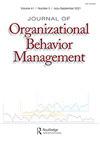Volume 43 Issue 1 of the Journal of Organizational Behavior Management
IF 1.2
3区 管理学
Q3 MANAGEMENT
Journal of Organizational Behavior Management
Pub Date : 2023-01-02
DOI:10.1080/01608061.2023.2171942
引用次数: 0
Abstract
Issue 1 of Volume 43 includes five manuscripts. First, Brown provides an evaluation of a pictorially enhanced self-instruction packet to improve submission of weekly billing sheets by employees at a clinic serving individuals with autism and related disabilities. This study is consistent with other recent evaluations of the effects of self-instruction packets as a method of training; these studies have generally found that self-instruction is often more efficient than in-vivo or even video-based instruction. Next, Ring and McGee describe a fascinating lab-based study in which they examine behavioral contrast, a phenomenon typically examined in the context of basic research. This study provides a much-needed link between organizational behavior management (OBM) and the work of our colleagues in the experimental analysis of behavior. It may also prompt additional basic-toorganizational research. Check it out! In the third manuscript in this issue, Juanico et al. describe an evaluation of a modified behavioral skills training (BST) package. The modification involves remote (as opposed to in-vivo) rehearsal and feedback using web-based technology. Technology-based applications of common behavioral procedures are increasingly popular, and this study provides a great model for similar evaluations to follow. Next, Gravina and colleagues provide a call to action for OBM. Demographic variables, such as race, sex, and socioeconomic status are important to describe in research, but have historically been neglected in behavior analysis and other sciences. These researchers compared the reporting of demographic variables in the Journal of Organizational Behavior Management to the Journal of Applied Psychology, which is the flagship journal in the field of Industrial and Organizational Psychology. Their results are very interesting! Finally, Johnson et al. provide an analysis of the form and function of performance feedback, the most widely used and studied intervention in OBM. This paper goes beyond reviewing feedback studies; it examines the many possible functions that feedback can serve. The authors also give some suggestions for giving, and importantly, receiving feedback. This paper is a must-read for anyone interested in OBM! A special issue or section of JOBM on “Teaching OBM” is planned for a later issue of Volume 43. Manuscripts will cover a variety of topics related to teaching OBM, including methods of instruction, preparation of students for JOURNAL OF ORGANIZATIONAL BEHAVIOR MANAGEMENT 2023, VOL. 43, NO. 1, 1–2 https://doi.org/10.1080/01608061.2023.2171942组织行为管理杂志第43卷第1期
第43卷第1期包括5份手稿。首先,Brown对一个图片增强的自我指导包进行了评估,以改进为自闭症和相关残疾患者服务的诊所员工每周提交的账单。这项研究与最近对自学包作为一种训练方法的效果的其他评估一致;这些研究普遍发现,自我指导往往比体内甚至基于视频的指导更有效。接下来,Ring和McGee描述了一项引人入胜的实验室研究,他们在研究中考察了行为对比,这是一种通常在基础研究中考察的现象。这项研究在组织行为管理(OBM)和我们同事在行为实验分析中的工作之间提供了一个急需的联系。它还可能促进额外的基础组织研究。看看吧!在本期的第三份手稿中,Juanico等人描述了对改进的行为技能培训(BST)包的评估。修改包括使用基于网络的技术进行远程(而不是体内)排练和反馈。基于技术的常见行为程序应用越来越受欢迎,这项研究为类似的评估提供了一个很好的模型。接下来,Gravina及其同事呼吁OBM采取行动。人口统计学变量,如种族、性别和社会经济地位,在研究中很重要,但在行为分析和其他科学中历来被忽视。这些研究人员将《组织行为管理杂志》和《应用心理学杂志》对人口统计学变量的报道进行了比较,后者是工业和组织心理学领域的旗舰期刊。他们的结果非常有趣!最后,Johnson等人分析了绩效反馈的形式和功能,这是OBM中最广泛使用和研究的干预措施。本文不仅回顾了反馈研究;它考察了反馈可以发挥的许多可能的功能。作者还提出了一些建议,以给予,更重要的是,接收反馈。这篇论文是任何对OBM感兴趣的人必读的!JOBM关于“教学OBM”的特刊或章节计划在第43卷的后期发行。手稿将涵盖与OBM教学相关的各种主题,包括教学方法、学生为《2023组织行为管理杂志》第43卷第1期1-2的准备https://doi.org/10.1080/01608061.2023.2171942
本文章由计算机程序翻译,如有差异,请以英文原文为准。
求助全文
约1分钟内获得全文
求助全文
来源期刊
CiteScore
2.70
自引率
47.60%
发文量
26
期刊介绍:
The Journal of Organizational Behavior Management—the official journal of the OBM Network (www.obmnetwork.com)—is a periodical devoted specifically to scientific principles to improve organizational performance through behavioral change. The journal publishes research and review articles, reports from the field, discussions, and book reviews on the topics that are critical to today"s organization development practitioners, operations managers, and human resource professionals.

 求助内容:
求助内容: 应助结果提醒方式:
应助结果提醒方式:


